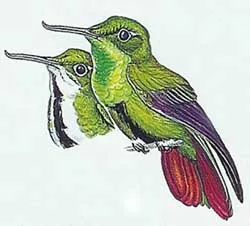 Fiery-tailed Awlbill (Avocettula recurvirostris) [order] APODIFORMES | [family] Trochilidae | [latin] Avocettula recurvirostris | [UK] Fiery-tailed Awlbill | [FR] Colibri avocette | [DE] Avosettkolibri | [ES] Mango Picolezna | [NL] Vuurstaartkluutkolibrie Subspecies
Physical charateristicsGreen hummingbird with a peculiar upturned bill. Upperparts green with brown gloss. Wings dull black and upper wing-coverts margined green. The slightly forked tail canetral pair of feahers dark green. Chin, throat and breast glossy green, lower underparts green except for a black streak on belly. Female is green above with a black streak across the running vertically across the breast. Rectrices have white tips. Black legs and bill not very long and with a upward turned tip. Listen to the sound of Fiery-tailed Awlbill [audio:http://www.aviflevoland.nl/sounddb/F/Fiery-tailed Awlbill.mp3]
RangeSouth America : Amazonia HabitatOpen savannah like vegetation near granite outcrops within primary forest. sometimes in edges of low vegetation near rivers. ReproductionThe nest is a small cup saddled on a thick branch of thick shrub or tree at 5-12 meter, into which two white eggs are laid. No further data. Feeding habitsDiet consists of nectar of flowers and sometimes anthropods, caught by hawking. Feeds nectar by trap lining. Forages at 1-3 meters up. ConservationThis species has a very large range, and hence does not approach the thresholds for Vulnerable under the range size criterion (Extent of Occurrence <20,000 km2 combined with a declining or fluctuating range size, habitat extent/quality, or population size and a small number of locations or severe fragmentation). The population trend is not known, but the population is not believed to be decreasing sufficiently rapidly to approach the thresholds under the population trend criterion (>30% decline over ten years or three generations). The population size has not been quantified, but it is not believed to approach the thresholds for Vulnerable under the population size criterion (<10,000 mature individuals with a continuing decline estimated to be >10% in ten years or three generations, or with a specified population structure). For these reasons the species is evaluated as Least Concern.  MigrationSedentary throughout range Distribution map |
]]>

